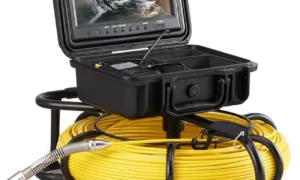The sweating guarded hotplate (SGHP) is a widely used method for measuring the thermal resistance and water vapor resistance of textiles. This method is based on the principle of a hot plate and is designed to simulate the human skin’s thermal and moisture management properties. The SGHP is a highly precise and accurate method for measuring the heat and moisture transfer properties of textiles, which are essential for evaluating their comfort and performance. In this article, we will discuss the SGHP method in detail and explain how it is used to measure textile water-vapor resistance.
Principle of the SGHP method:
The SGHP method involves placing a textile sample on a heated plate and measuring the heat flow and water vapor transmission through the sample. The heated plate is typically maintained at a constant temperature of 35°C or 37°C, which is the typical skin temperature. The plate is also covered with a layer of water to simulate the moisture present on the skin’s surface.
The textile sample is placed on top of the plate, and a load is applied to ensure good contact between the sample and the plate. The sample is then clamped between two plates, and the heat flow and water vapor transmission through the sample are measured. The heat flow is measured using a heat flux sensor, while the water vapor transmission is measured using a humidity sensor.
The heat flow and water vapor transmission measurements are used to calculate the thermal resistance and water vapor resistance of the textile sample. The thermal resistance is a measure of how well the textile sample insulates against heat transfer, while the water vapor resistance is a measure of how well the textile sample allows water vapor to pass through.
Applications of the SGHP method:
The SGHP method is widely used in the textile industry to evaluate the thermal and moisture management properties of fabrics. The method is particularly useful for evaluating the comfort and performance of textiles intended for use in clothing, bedding, and other products that come into contact with the skin.
The thermal resistance and water vapor resistance values obtained from the SGHP method can be used to predict the thermal and moisture management properties of the textile in real-world conditions. For example, textiles with low thermal resistance and high water vapor resistance are more comfortable to wear in hot and humid conditions because they allow heat to escape and moisture to evaporate more easily.
The SGHP method is also used in the development and testing of advanced textile materials such as smart fabrics and functional textiles. These textiles are designed to have specific thermal and moisture management properties that can be tailored to specific applications. The SGHP method is an essential tool for evaluating the performance of these advanced textiles and ensuring that they meet the desired specifications.
Challenges in measuring textile water-vapor resistance:
Measuring textile water-vapor resistance is challenging because it is influenced by many factors, including the type of fiber, yarn, and fabric construction. The water-vapor resistance of a textile also depends on the environmental conditions, such as temperature and humidity, and the skin’s moisture content.
To obtain accurate and reliable water-vapor resistance values, it is essential to use a standardized testing method such as the SGHP method. However, even with the SGHP method, there are some challenges in measuring textile water-vapor resistance.
One challenge is ensuring that the textile sample is in contact with the heated plate and the layer of water. If the sample is not in good contact with the plate or if there are air gaps between the sample and the water layer, the water-vapor transmission measurements may be inaccurate.
Another challenge is accounting for the edge effects of the textile sample. The edge effects occur because the heat and moisture transfer through the edges of the sample is different from that through the center of the sample. To account for these edge effects, it is necessary to use a large enough sample size and to apply a correction factor to the measurements
Textile water-vapor resistance:
Textile water-vapor resistance is an essential property of textiles that affects their comfort and performance. Water-vapor resistance is a measure of how well a textile allows water vapor to pass through. This property is essential because it determines how well a textile can manage moisture and heat transfer, which is critical for maintaining comfort.
Textiles with high water-vapor resistance are less breathable, which means they are less effective at allowing moisture to evaporate from the skin. This can result in discomfort and increased sweating. Textiles with low water-vapor resistance are more breathable and allow moisture to evaporate more easily, resulting in improved comfort.
Measuring water-vapor resistance is challenging because it is influenced by many factors, including the type of fiber, yarn, and fabric construction. Standardized testing methods such as the SGHP method are essential for obtaining accurate and reliable water-vapor resistance values.
The SGHP method is also useful for evaluating the effectiveness of various moisture management treatments applied to textiles. For example, textiles can be treated with various finishes and coatings to improve their moisture management properties. The SGHP method can be used to evaluate the effectiveness of these treatments and to determine the optimal treatment for a particular application.
Conclusion:
The SGHP method is a highly precise and accurate method for measuring the thermal resistance and water-vapor resistance of textiles. This method is widely used in the textile industry to evaluate the comfort and performance of textiles intended for use in clothing, bedding, and other products that come into contact with the skin.
Measuring water-vapor resistance is challenging, but standardized testing methods such as the SGHP method are essential for obtaining accurate and reliable results. The water-vapor resistance of a textile is an essential property that affects its comfort and performance. Textiles with high water-vapor resistance are less breathable, while textiles with low water-vapor resistance are more breathable and allow moisture to evaporate more easily.
Overall, the SGHP method is a powerful tool for evaluating the thermal and moisture management properties of textiles and for developing advanced textile materials with specific properties tailored to specific applications.





























